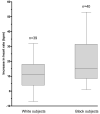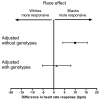Genetic variants in the alpha2C-adrenoceptor and G-protein contribute to ethnic differences in cardiovascular stress responses
- PMID: 18698227
- PMCID: PMC2689621
- DOI: 10.1097/FPC.0b013e3282fee5a1
Genetic variants in the alpha2C-adrenoceptor and G-protein contribute to ethnic differences in cardiovascular stress responses
Abstract
Objectives: Cardiovascular responses to stressors are regulated by sympathetic activity, increased in black Americans, and associated with future cardiovascular morbidity. Our aim was to determine whether two functional variants in genes regulating sympathetic activity, a deletion in the alpha2C-adrenergic receptor (ADRA2C del322-325) and a G-protein beta3-subunit variant (GNB3 G825T), affect cardiovascular responses to physiologic stressors and contribute to their ethnic differences.
Methods: We measured heart rate and blood pressure responses to a cold pressor test (CPT) in 79 healthy participants (40 blacks, 39 whites), aged 25.7+/-5.3 years, and determined genotypes for the ADRA2C and GNB3 variants. We examined the response variables (increase in heart rate and blood pressure) in multiple linear regression analyses adjusting first for baseline measures, ethnicity, and other covariates, and then additionally for genotypes.
Results: Black participants had a greater heart rate response to CPT than whites [mean difference, 9.9 bpm; 95% confidence interval (CI), 4.1 to 15.6; P=0.001]. Both the ADRA2C del/del (15.8 bpm; 95% CI, 8.0-23.7; P<0.001) and GNB3 T/T genotypes (6.8 bpm; 95% CI, 0.9-12.7; P=0.026) were associated with greater heart rate response. After adjusting for genotypes, the ethnic difference was abrogated (1.3 bpm; 95% CI, -5.4-8.0; P=0.70), suggesting that the genetic variants contributed substantially to ethnic differences.
Conclusion: Variation in genes that regulate sympathetic activity affects hemodynamic stress responses and contributes to their ethnic differences. This study elucidates how genetic factors may in part explain ethnic differences in cardiovascular regulation.
Figures



Similar articles
-
Effects of variation in the human alpha2A- and alpha2C-adrenoceptor genes on cognitive tasks and pain perception.Eur J Pain. 2010 Feb;14(2):154-9. doi: 10.1016/j.ejpain.2009.04.003. Epub 2009 May 6. Eur J Pain. 2010. PMID: 19423370 Free PMC article.
-
Ethnic and genetic determinants of cardiovascular response to the selective alpha 2-adrenoceptor agonist dexmedetomidine.Hypertension. 2008 Feb;51(2):406-11. doi: 10.1161/HYPERTENSIONAHA.107.098939. Epub 2007 Dec 10. Hypertension. 2008. PMID: 18071056
-
Effect of the alpha2C-adrenoreceptor deletion322-325 variant on sympathetic activity and cardiovascular measures in healthy subjects.J Hypertens. 2007 Apr;25(4):763-71. doi: 10.1097/HJH.0b013e328017f6e9. J Hypertens. 2007. PMID: 17351367
-
Racial differences in stress-induced cardiovascular reactivity and hypertension: current status and substantive issues.Psychol Bull. 1989 Jan;105(1):89-105. doi: 10.1037/0033-2909.105.1.89. Psychol Bull. 1989. PMID: 2648440 Review.
-
Neural control of cardiovascular function in black adults: implications for racial differences in autonomic regulation.Am J Physiol Regul Integr Comp Physiol. 2020 Feb 1;318(2):R234-R244. doi: 10.1152/ajpregu.00091.2019. Epub 2019 Dec 11. Am J Physiol Regul Integr Comp Physiol. 2020. PMID: 31823675 Free PMC article. Review.
Cited by
-
Angiotensin AT1 - α2C-Adrenoceptor Interaction Disturbs α2A-auto-Inhibition of Catecholamine Release in Hypertensive Rats.Front Neurol. 2013 Jun 10;4:70. doi: 10.3389/fneur.2013.00070. eCollection 2013. Front Neurol. 2013. PMID: 23772221 Free PMC article.
-
Genetic variation in the alpha1B-adrenergic receptor and vascular response.Pharmacogenomics J. 2017 Jul;17(4):366-371. doi: 10.1038/tpj.2016.29. Epub 2016 Apr 19. Pharmacogenomics J. 2017. PMID: 27089938 Free PMC article.
-
Genome-wide linkage and regional association study of blood pressure response to the cold pressor test in Han Chinese: the genetic epidemiology network of salt sensitivity study.Circ Cardiovasc Genet. 2014 Aug;7(4):521-8. doi: 10.1161/CIRCGENETICS.113.000332. Epub 2014 Jul 15. Circ Cardiovasc Genet. 2014. PMID: 25028485 Free PMC article. Clinical Trial.
-
Effects of variation in the human alpha2A- and alpha2C-adrenoceptor genes on cognitive tasks and pain perception.Eur J Pain. 2010 Feb;14(2):154-9. doi: 10.1016/j.ejpain.2009.04.003. Epub 2009 May 6. Eur J Pain. 2010. PMID: 19423370 Free PMC article.
-
Racial differences in takotsubo cardiomyopathy outcomes in a large nationwide sample.ESC Heart Fail. 2020 Jun;7(3):1056-1063. doi: 10.1002/ehf2.12664. Epub 2020 Mar 9. ESC Heart Fail. 2020. PMID: 32147963 Free PMC article.
References
-
- Matthews KA, Katholi CR, McCreath H, Whooley MA, Williams DR, Zhu S, et al. Blood pressure reactivity to psychological stress predicts hypertension in the CARDIA study. Circulation. 2004;110:74–78. - PubMed
-
- Robertson D, Biaggioni I, Burnstock G, Low PA. Primer on the autonomic nervous system. 2nd edition Elsevier Academic Press; San Diego, CA: 2004.
-
- O'Connor DT, Insel PA, Ziegler MG, Hook VY, Smith DW, Hamilton BA, et al. Heredity and the autonomic nervous system in human hypertension. Curr Hypertens Rep. 2000;2:16–22. - PubMed
-
- Flordellis C, Manolis A, Scheinin M, Paris H. Clinical and pharmacological significance of alpha2-adrenoceptor polymorphisms in cardiovascular diseases. Int J Cardiol. 2004;97:367–372. - PubMed
-
- Williams PD, Puddey IB, Beilin LJ, Vandongen R. Genetic influences on plasma catecholamines in human twins. J Clin Endocrinol Metab. 1993;77:794–799. - PubMed
Publication types
MeSH terms
Substances
Grants and funding
LinkOut - more resources
Full Text Sources
Other Literature Sources
Medical
Molecular Biology Databases

